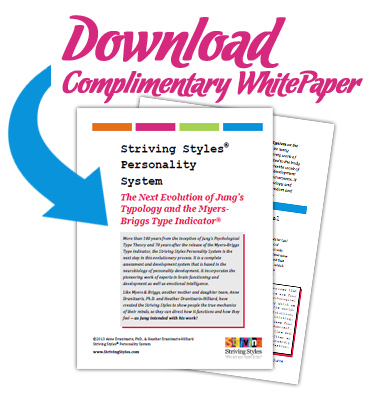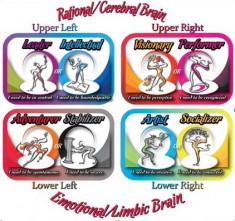An Evolution of Jung and Myers-Briggs
An Evolution of Jung and Myers-Briggs
More than 100 years from the inception of Jung’s Psychological Type Theory and 70 years after the release of the Myers-Briggs Type Indicator, the Striving Styles Personality System is the next step in this evolutionary process. It is a complete assessment and development system that is based in the neurobiology of personality development. It incorporates the pioneering work of experts in brain functioning and development as well as emotional intelligence.
Like Myers & Briggs, another mother and daughter team, Anne Dranitsaris, Ph.D. and Heather Dranitsaris-Hilliard, have created the Striving Styles to show people the true mechanics of their minds, so they can direct how it functions and how they feel -- as Jung intended with his work!
The SSPS is a way of understanding the more dynamic and interpersonal aspects of an individual’s personality and how their needs and emotions cause shifts in behavior. It incorporates the neuroscience of personality and brain development, it allows us to leverage what we have learned through the MBTI personality test. As a result, we can now enhance our ability to understand and help others achieve their potential.
Adapting Jung’s Theory & the MBTI to Advances in Neuroscience
Now that we have embraced the developments in brain specialization and dominance and incorporated them into the SSPS, people are now able to gain more insight into how their brains work and take charge of their own personal growth and development.
Finally, everyone dedicated to using Psychological Type theory, the MBTI and other related personality tests can integrate the advantages of brain science and neuroplasticity. With the SSPS, personality type becomes something that everyone must know about to achieve their potential in life.
Learn more about the SSPS and how it evolved from Psychological Type theory and the Myers-Briggs Type Indicator.
Learn about the brain organization of each of the 16 Types and the innate needs that drive their behavior. >>>

Download Here

Register for one of our upcoming complimentary webinars to learn more about incorporating the SSPS into your work with Type. Learn more...

Each of the Styles represent one of Jung's 8 function & attitude combinations (e.g., the Leader Striving Style is Extroverted Thinking) and play a different role in our personality based on where they are located in the brain.
LEARN ABOUT THE BRAIN ORGANIZATION OF EACH OF THE MBTI TYPES






